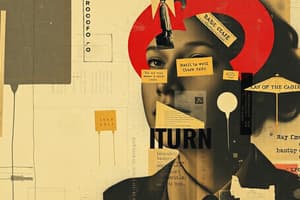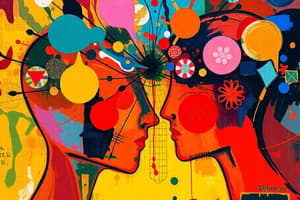Podcast
Questions and Answers
Which theory posits that emotions and arousal occur simultaneously?
Which theory posits that emotions and arousal occur simultaneously?
- Cognitive Appraisal Theory
- James-Lange Theory
- Schachter-Singer Two-Factor Model
- Cannon-Bard Theory (correct)
What is described as a driving force that initiates and directs behavior?
What is described as a driving force that initiates and directs behavior?
- Desire
- Motivation (correct)
- Affect
- Emotion
Which of the following is NOT considered a basic emotion?
Which of the following is NOT considered a basic emotion?
- Happiness
- Excitement (correct)
- Fear
- Anger
In Schachter and Singer’s two-factor model, what two elements combine to create emotion?
In Schachter and Singer’s two-factor model, what two elements combine to create emotion?
What role does the thalamus play in the experience of emotion?
What role does the thalamus play in the experience of emotion?
Secondary emotions are particularly characterized by which component?
Secondary emotions are particularly characterized by which component?
Which of the following best describes the James-Lange theory of emotion?
Which of the following best describes the James-Lange theory of emotion?
What is self-efficacy primarily defined as?
What is self-efficacy primarily defined as?
Which hormone is primarily responsible for signaling hunger?
Which hormone is primarily responsible for signaling hunger?
How does optimism influence an individual's stress response?
How does optimism influence an individual's stress response?
What is the primary reason that personal income does not correlate with happiness?
What is the primary reason that personal income does not correlate with happiness?
Anorexia nervosa is characterized by which of the following?
Anorexia nervosa is characterized by which of the following?
What does the Two-Factor Theory of Emotion suggest is necessary to experience emotion?
What does the Two-Factor Theory of Emotion suggest is necessary to experience emotion?
What is the term for the tendency to incorrectly label the source of arousal?
What is the term for the tendency to incorrectly label the source of arousal?
Which of the following is NOT a form of nonverbal communication?
Which of the following is NOT a form of nonverbal communication?
What physiological syndrome may occur as a response to extreme negative stressors?
What physiological syndrome may occur as a response to extreme negative stressors?
Which phase is NOT part of the general adaptation syndrome in response to long-term stress?
Which phase is NOT part of the general adaptation syndrome in response to long-term stress?
What can be a negative health consequence of prolonged stress?
What can be a negative health consequence of prolonged stress?
Which method would NOT typically be successful in coping with stress?
Which method would NOT typically be successful in coping with stress?
How does the body typically respond when faced with emotional or physical threats?
How does the body typically respond when faced with emotional or physical threats?
What is a common symptom experienced in individuals with posttraumatic stress disorder (PTSD)?
What is a common symptom experienced in individuals with posttraumatic stress disorder (PTSD)?
What happens during the general alarm reaction stage of stress?
What happens during the general alarm reaction stage of stress?
In the resistance stage, how does the body attempt to cope with ongoing stress?
In the resistance stage, how does the body attempt to cope with ongoing stress?
What is a potential outcome of prolonged stress during the exhaustion stage?
What is a potential outcome of prolonged stress during the exhaustion stage?
Which hormones are primarily associated with the body's response to stress?
Which hormones are primarily associated with the body's response to stress?
Men are more likely than women to respond to stress through which mechanism?
Men are more likely than women to respond to stress through which mechanism?
What does the Stress Scale developed by Rahe and colleagues allow individuals to determine?
What does the Stress Scale developed by Rahe and colleagues allow individuals to determine?
During the exhaustion stage, what happens to blood sugar levels?
During the exhaustion stage, what happens to blood sugar levels?
What is the significance of the HPA axis in stress response?
What is the significance of the HPA axis in stress response?
Which is NOT a consequence of the exhaustion stage?
Which is NOT a consequence of the exhaustion stage?
What role does cortisol play during stress?
What role does cortisol play during stress?
What is the tend-and-befriend response typically associated with?
What is the tend-and-befriend response typically associated with?
What does emotion regulation refer to?
What does emotion regulation refer to?
Which of the following best describes the 'power of positive thinking'?
Which of the following best describes the 'power of positive thinking'?
What is an effect of thinking positively about the future?
What is an effect of thinking positively about the future?
Which gender is noted as being more likely to engage in the tend-and-befriend response?
Which gender is noted as being more likely to engage in the tend-and-befriend response?
What factor increases happiness according to the content?
What factor increases happiness according to the content?
Which of the following is a common misconception about emotion regulation?
Which of the following is a common misconception about emotion regulation?
How might someone with effective emotion regulation respond to stress?
How might someone with effective emotion regulation respond to stress?
What is a recommended approach to changing coping mechanisms?
What is a recommended approach to changing coping mechanisms?
Which of the following factors does NOT contribute to happiness?
Which of the following factors does NOT contribute to happiness?
Flashcards
Affect
Affect
A mental and physiological state that directs our attention and guides our behavior.
Basic Emotions
Basic Emotions
Basic emotions like anger, disgust, fear, happiness, sadness, and surprise. They are innate and universal.
Secondary Emotions
Secondary Emotions
Emotions like love, guilt, shame, and pride. They develop over time and involve cognitive appraisal.
Cannon-Bard Theory
Cannon-Bard Theory
Signup and view all the flashcards
James-Lange Theory
James-Lange Theory
Signup and view all the flashcards
Two-Factor Theory of Emotion
Two-Factor Theory of Emotion
Signup and view all the flashcards
Fast and Slow Pathways for Emotional Processing
Fast and Slow Pathways for Emotional Processing
Signup and view all the flashcards
Misattribution of Arousal
Misattribution of Arousal
Signup and view all the flashcards
Stress
Stress
Signup and view all the flashcards
Posttraumatic Stress Disorder (PTSD)
Posttraumatic Stress Disorder (PTSD)
Signup and view all the flashcards
General Adaptation Syndrome (GAS)
General Adaptation Syndrome (GAS)
Signup and view all the flashcards
Alarm Phase
Alarm Phase
Signup and view all the flashcards
Resistance Phase
Resistance Phase
Signup and view all the flashcards
Exhaustion Phase
Exhaustion Phase
Signup and view all the flashcards
Nonverbal Communication
Nonverbal Communication
Signup and view all the flashcards
Stress Coping Methods
Stress Coping Methods
Signup and view all the flashcards
General Alarm Reaction
General Alarm Reaction
Signup and view all the flashcards
Resistance Stage
Resistance Stage
Signup and view all the flashcards
Exhaustion Stage
Exhaustion Stage
Signup and view all the flashcards
HPA Axis
HPA Axis
Signup and view all the flashcards
Cortisol
Cortisol
Signup and view all the flashcards
Epinephrine
Epinephrine
Signup and view all the flashcards
Norepinephrine
Norepinephrine
Signup and view all the flashcards
Fight-or-Flight Response
Fight-or-Flight Response
Signup and view all the flashcards
Stress Scale
Stress Scale
Signup and view all the flashcards
Optimism
Optimism
Signup and view all the flashcards
Self-efficacy
Self-efficacy
Signup and view all the flashcards
Hardiness
Hardiness
Signup and view all the flashcards
Appetite Hormones
Appetite Hormones
Signup and view all the flashcards
Anorexia Nervosa
Anorexia Nervosa
Signup and view all the flashcards
Tend-and-Befriend
Tend-and-Befriend
Signup and view all the flashcards
Emotion Regulation
Emotion Regulation
Signup and view all the flashcards
Power of Positive Thinking
Power of Positive Thinking
Signup and view all the flashcards
Positive Emotions
Positive Emotions
Signup and view all the flashcards
Happiness Factors
Happiness Factors
Signup and view all the flashcards
Stress Response
Stress Response
Signup and view all the flashcards
Stress Management Techniques
Stress Management Techniques
Signup and view all the flashcards
Emotional Control
Emotional Control
Signup and view all the flashcards
Emotions and Health
Emotions and Health
Signup and view all the flashcards
Study Notes
Emotions and Motivations
- Emotions are mental and physiological states that direct attention and guide behavior. They influence our actions and have an adaptive role or can be destructive.
- Motivations are driving forces that initiate and direct behavior. They can be biological (food, water, and sex) or personal/social (social approval, acceptance, achievement, risk-taking).
- Affect is the experience of feeling or emotion.
The Experience of Emotion
- Learning objectives include explaining the biological experience of emotion, summarizing psychological theories of emotion, and giving examples of how emotion is communicated.
- Basic emotions include anger, disgust, fear, happiness, sadness, and surprise.
Secondary Emotions
- Secondary emotions have a major cognitive component.
- They are determined by both arousal level (low to high) and valence (pleasant to unpleasant).
Emotions & Brain Pathways
- The thalamus acts as a major gatekeeper in the process of emotion.
- A fast pathway and a slow pathway exist.
Theories of Emotion
- Cannon-Bard theory suggests emotions and arousal occur at the same time.
- James-Lange theory proposes that emotion results from arousal.
- Schachter-Singer's two-factor model suggests arousal and cognition combine to create emotion.
- The two-factor theory states that the intensity of arousal determines the emotion, while cognitive appraisal determines the specific emotion. Misattribution of arousal is when people incorrectly label the source of arousal.
Communicating Emotion
- Nonverbal communication includes tone of voice, gait, posture, touch, and facial expressions.
- There is no universal nonverbal language. Various examples of nonverbal cues and their potential meanings are provided.
Exercises and Critical Thinking
- Students are asked to consider several theories, provide examples, and describe their own experiences with emotions and stress.
Stress: The Unseen Killer
- Stress is the physiological response when an organism fails to respond appropriately to threats. Extreme stress can include PTSD.
- Learning objectives include defining stress and reviewing the body's physiological responses, summarizing negative health consequences of prolonged stress, explaining differences in how people respond, and reviewing stress-coping methods.
- General Adaptation Syndrome (GAS) involves three stages: alarm (mobilize resources), resistance (coping with stressor), and exhaustion (reserves depleted). Exhaustion includes lowered stress tolerance, illness, and possible death.
- The hypothalamic-pituitary-adrenal (HPA) axis is activated by stress, leading to cortisol, norepinephrine, and epinephrine release.
Responses to Stress
- Men are more likely to respond to stress with a fight-or-flight response.
- Women are more likely to engage in tend-and-befriend behaviors.
How to Manage Stress Effectively?
- Suppressing or facing stressful situations, and interpreting them accurately can help to manage stress.
Positive Emotions: The Power of Happiness
- Learning objectives include understanding the role of positive emotions in responding to stress and factors affecting happiness.
- Positive thinking, optimism, self-efficacy, and hardiness are considered key elements for responding to stress.
- Positive social relationships and the perception of social support contribute to happiness.
Income and Happiness
- Although personal income increases, happiness does not necessarily follow the same pattern.
Eating and Mating
- Eating behavior is influenced by biological, psychological, and social-cultural factors.
- Appetite hormones (insulin, leptin, orexin, ghrelin) influence eating.
- Sex is a fundamental human motivation. Stages of sexual response (excitement, plateau, orgasm, resolution) are discussed.
- Sexual orientation, including heterosexual, homosexual, and bisexual orientation, is variable.
Eating Disorders
- Anorexia nervosa, bulimia nervosa, and obesity are characterized by different features related to body weight, disordered eating, and perception.
Questions?
Studying That Suits You
Use AI to generate personalized quizzes and flashcards to suit your learning preferences.




